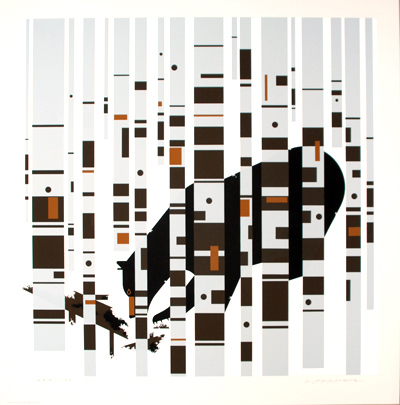

One of the most frequent topics for questions about Charley’s prints involves the numbering of limited edition prints. This article will explain what a limited edition serial number is and what it means. Numbered limited editions are print runs which are fixed at a certain number of prints issued. By the end of this article you will understand what this means and perhaps have your other questions about serial numbers answered.
The Frame House Gallery, of Louisville Kentucky produced numbered limited edition prints after the work of Charley Harper. Each print was produced from a master painting or prototype, using a technique known as seriography, or commonly ‘silk screening’. Each color in the print was put down using a separate screen perfectly registered in each print. Upon completion, each print in the series was signed by the artist, and also numbered. These two items, the signature and the serial number, provide two important functions.
The signature on Charley’s prints is often the best mark of authenticity; he has a distinctive signature which is readily identifiable, even as it evolved over time. As most of these editions are long sold out, they are typically available only on the secondary art market, and many do not contain all of the originally issued flyers, marketing materials, handling instructions and Certificates of Authenticity shipped with the newly issued print. So, again, Charley’s signature is often the best available mark of authenticity for signed limited edition prints.
The serial number indicates the number of the individual print and the total number of prints made in the limited edition series. In the image, above, we see that the print serial number is ‘767’, and the total number of prints made in this image was 1500. So, we are looking at print number 767 out of a total of 1500 produced. According to The Frame House Gallery “After the edition is completed the plates and negatives are destroyed and so certified … assurance that no future editions will ever be published.” This is important for collectors to know because it indicates the relative scarcity of an individual print. The numbered limited edition prints made of Charley’s work were issued in series of 500, 750, 1000, 1500, and 2000 prints. This range of values indicates the relative scarcity of each series of prints, as issued. And, this can inform one aspect of value (others are image popularity, print size, etc.) Limited edition prints (as opposed to open edition prints) are relatively harder to find, in limited supply, and therefore more desirable and valuable as a potential investment.
We are often asked ‘what number’ (meaning which serial number) is available for a given print offered for sale. In some cases the question is prompted by a desire to have a ‘low number’, or a specific number which has a significance to the buyer. However, each print in the series is identical and not is worth more than another by virtue of the serial number. A low numbered print is no more valuable than a higher numbered print. In our practice The Gallery typically sends the lowest number on hand at the time an order is received, unless otherwise requested.
Another question we have fielded this year is ‘why do so many prints for sale have the same number?’ The answer to this requires some explanation and is due to a pair of factors. First, The Frame House Gallery sold prints through subscriptions, in concert with local art dealers. “Many collectors arrange with their gallery for an automatic plan whereby they are able to purchase each of the artist’s new prints. In return, the collector is assured of receiving each print with the same number in the edition. Many collectors have become devoted followers of a particular artist, buying everything the artist produces over the years.” So, collectors subscribed to receive Charley’s prints over time, all with the same serial number. In essence they ‘reserved’ a specific serial number for themselves. The second factor is that these collections are often sold as a group in private sales or on the secondary art market. As one of the largest Harper dealers in the world, we purchase a large number of collections for resale, every year. That is why you may see many different prints – all with the same serial number. Typically, an individual collector has sold their collection of limited edition prints – all bearing the same serial number.
In summary, a print serial number indicates that the production of that image was limited, and indicates the size of the series (i.e., number of prints produced). The limited nature of the production assures that no future copies will be made of that image, and that creates a scarcity of supply which does affect appreciation and future value. For example, the “Bear in the Birches” print was available for sale in 1976 at an issue price of $35. Today that limited edition print is commonly sold for $1600-1800! The serial number itself (low or high) does not affect the print’s value. That is, the important thing from a collectability/value point of view is that there is a serial number and the production of that specific print was limited to a finite number. The specific number is not a value driver.
We hope you’ve enjoyed this article and welcome any comments. The Charley Harper Gallery is an authorized dealer of the Harper Estate and was established to further the appreciation and availability of Charley’s wonderful artwork, which has done so much to represent nature, conservation and the wellbeing of the planet in an uplifting way. Thanks for reading our blog and for your patronage over the years. We welcome your questions and other inquiries. The Gallery is always buying Charley’s work and would be glad to receive purchase inquiries.